CBD PRESS RELEASE
Women’s participation on Singapore boards reaching 20% at top companies, 30% at statutory boards: Council for Board Diversity
• Women’s participation on boards (“WOB”) of the 100 largest companies listed on the Singapore Exchange (“SGX”) increased to 19.7 per cent as at 1 Jan 2022, from 17.6 per cent in Dec 2020.
• WOB of the 100 largest companies listed on SGX first increased to 18.9 per cent as at 31 Dec 2021, before rising further to 19.7 per cent on 1 Jan 2022.
• Women’s share of directorships at statutory boards rose to 29.7 per cent as at end-2021 following a net increase of 25 women directors.
• At the 100 largest Institutions of a Public Character (“Top 100 IPCs”), women’s share of directorships stayed broadly the same. It slipped 0.4 percentage points to 28.4 per cent due to changes in the constituents of the Top 100.
• The number of long-serving independent directors on the Top 100 companies decreased to 50, or 10 per cent of independent directors, at end-2021 from 87, or 17 per cent of independent directors, in 2020, reflecting improvements in board renewal in 22 companies.
• A key driver for board refreshment was the nine-year rule for independent directors, which took effect on 1 Jan 2022
Singapore, 22 March 2022 – As a bellwether for overall board diversity, women’s participation on boards (“WOB”) rose significantly in Singapore’s largest private and public sector organisations in 2021. The progress is an encouraging signal of leadership commitment to diversity in uncertain and difficult times.
Data compiled by Singapore’s Council for Board Diversity (“CBD”) showed that women held 18.9 per cent of the board seats on the largest 100 primary-listed companies on SGX (“Top 100 companies”) at end-2021, up 1.3 percentage points from 17.6 per cent a year earlier. Top 100 companies further lifted WOB by 0.8 percentage points to 19.7 per cent on 1 Jan 2022, with appointments of 11 women directors, as the nine-year rule on director independence took effect on SGX. This is in addition to the 25 women directors appointed in 2021. During the same period, from 1 Jan 2021 to 1 Jan 2022, 20 women directors stepped down.
WOB among statutory boards improved the most, building on previous years’ advance. Women’s representation increased 2.2 percentage points to 29.7 per cent as at 31 Dec 2021 from 27.5 per cent a year ago, widening the range of views for the role that statutory boards play. In 2021, 54 women were appointed to statutory boards, while 29 women directors stepped down.
The percentage of board seats held by women among the Top 100 IPCs stayed broadly the same. It slipped 0.4 percentage points to 28.4 per cent from a year ago, but this was due to differences in the organisations that made up the Top 100 IPCs. Excluding the effect of changes in constituents, WOB among the Top 100 IPCs would have been 29.0 per cent, an improvement of 0.2 percentage points.

More women chairing statutory boards
Women chaired 23 per cent of statutory boards as at end-2021, 9 per cent among Top 100 companies, and 16 per cent among Top 100 IPCs. Boards led by women across the three sectors tend to have a higher percentage of WOB, which probably indicates that boards with female chairs are more likely to have embraced a broad range of diversity.

More gender-balanced boards seen in public sector organisations
The number of gender-balanced boards, defined as having 40 to 60 per cent comprising either gender, increased among statutory boards to 18 per cent as at end-2021, double the share from a year ago. However, the proportion of gender-balanced Top 100 company boards was stagnant at 4 per cent, and declined among the Top 100 IPCs to 17 per cent, from 22 per cent.
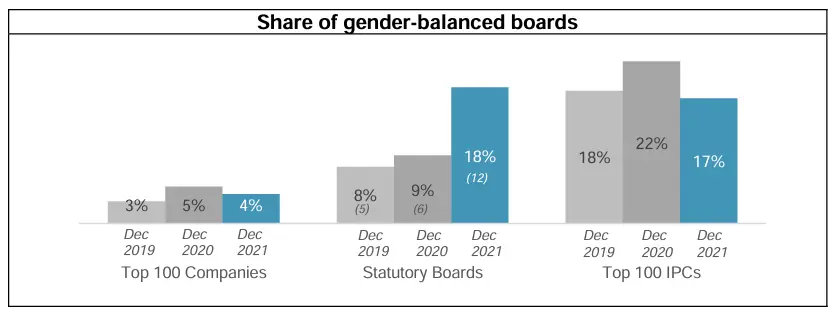
Mildred Tan, Co-Chair of the CBD and Chair of Tote Board Singapore and Singapore University of Social Sciences Board of Trustees, said: “Singapore’s statutory boards demonstrate how quickly it is possible to diversify our boards. The progress augers well for many capable women to demonstrate their ability to thrive in our boardrooms.
“The pandemic has caused significant disruption in our society over the past two years, in turn causing many IPCs to face new challenges in meeting the needs of their beneficiaries with increased funding constraints. In times like these, it is more important than ever for IPCs to build a diverse mix of directors who reflect the communities they serve.”
Corporate board renewal drives improvements in diversity
The percentage of board appointments who were first-time directors reached 59 per cent in 2021. This was the highest since tracking began in 2015. The growth of first-time directors enlarges the pool of board talent in the market.
The rise in board renewal coincides with the coming-into-force of the nine-year rule on director independence announced in 2018, which took effect on 1 Jan 2022. Under the rule, long-serving directors whose tenures are nine years and above can only be voted as independent directors by shareholders excluding directors, chief executives and associates.
22 companies with long-serving independent directors (“LSID”) made reductions in the number of LSID, with 12 of them no longer having any LSID. This leaves 31 of the Top 100 companies with long-serving independent directors as at 31 Dec 2021, down from 43 as at end-2020. The proportion of LSID over all independent directors significantly reduced from 17% at end-2020 to 10% at end-2021.
Mr Loh Boon Chye, Co-Chair, CBD and CEO, SGX, said: “Seeing record highs in board appointments and first-time directors is very encouraging. It shows our largest companies taking board renewal and director independence in the right spirit, setting an example for the rest of the market.
“Organisations today navigate heightened uncertainty and answer to discerning stakeholders on governance and sustainability. Boards in both private and public organisations must take into consideration not just their organisations’ needs, but also the stakeholders they serve. When we seek out the unique viewpoints and lived experiences of directors from different backgrounds, our boards become greater than the sum of their parts.”
For details on each organisation’s proportion of women’s participation on boards, refer to Annex B paragraph 12, Annex C paragraph 7, and Annex D paragraph 6.
Highlights on Top 100 companies
1. Women held 18.9 per cent of board seats in the Top 100 companies as at end-2021, up 1.3 percentage points from 17.6 per cent a year earlier. Excluding the effect of changes in constituents in the Top 100 companies, the WOB percentage at end-2021 would have been 19.2 per cent. As at 1 Jan 2022, women held 19.7% of board seats in the Top 100 companies. (See Annex B, point 1)

2. The number of all-male boards among the Top 100 companies remained roughly unchanged at 17 in 2021, from 18 at the end of 2020. It was reduced to 15 on 1 Jan 2022, as two all-male boards appointed women onto their boards. (See Annex B, point 2)
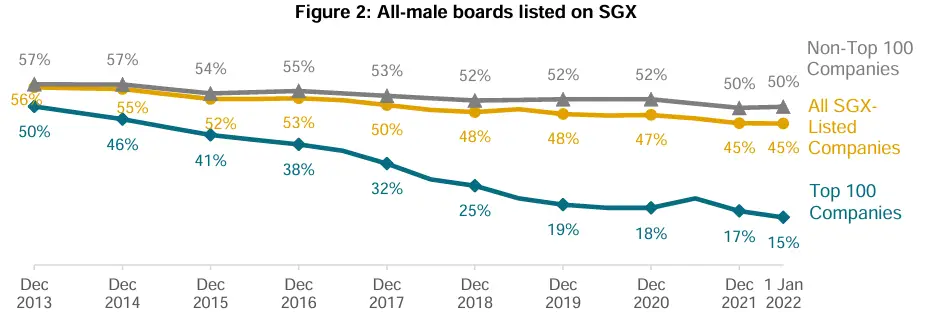
3. Six all-male boards such as Thomson Medical Group Limited and Keppel Pacific Oak US REIT and 20 other companies appointed more women onto their boards between 1 Jan 2021 and 1 Jan 2022. (See Annex B, point 3)
4. Since 2013, 12 of the Top 100 companies have gone from all-male boards to having at least 25 per cent WOB as at 31 Dec 2021. Of these 12, three had gender-balanced boards as at end-2021 – Far East Hospitality Trust, SATS Ltd and Singapore Post Ltd (Table 1).
Highlights on statutory boards
1. Women held 29.7 per cent of board seats in Singapore’s 65 statutory boards as at end-2021, up from 27.5 per cent a year ago. (See Annex C, point 1)
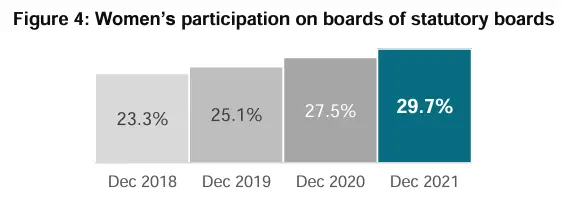
2. Almost a quarter of statutory boards are chaired by women (14 out of 65) as at end-2021. (See Annex C, point 2)
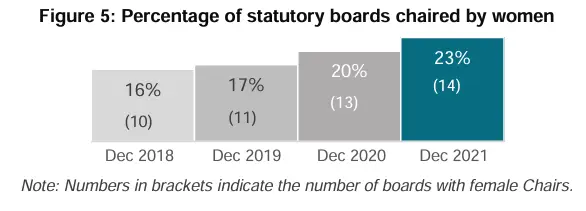
3. The proportion of statutory boards that have achieved the target of at least 30 per cent women participation on their boards rose to 35 per cent as at end-2021, from 31 per cent a year earlier. (See Annex C, point 3)
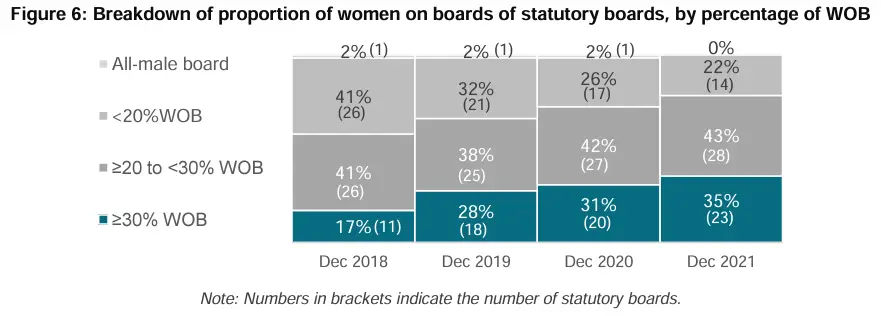
4. 30 statutory boards appointed 54 women onto their boards in 2021. (See Annex C, point 4)
5. The top 3 ministries whose statutory boards have the highest average %WOB are Ministry of Health (MOH), Ministry of Social and Family Development (MSF), Ministry of Culture, Community and Youth (MCCY), and Ministry of Manpower (MOM).

Highlights on Top 100 IPCs
1. Women held 28.4 per cent of board seats in the Top 100 IPCs as at end-2021, down from 28.8 per cent a year ago. (See Annex D, point 1)
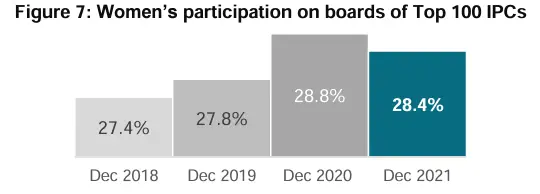
2. 16% of Top 100 IPCs are chaired by women. (See Annex D, point 2)

3. Small change in number of Top 100 IPCs that have achieved the target of at least 30 per cent women participation on their boards, at 46 as at end-2021. Four all-male boards remain. (See Annex D, point 3)
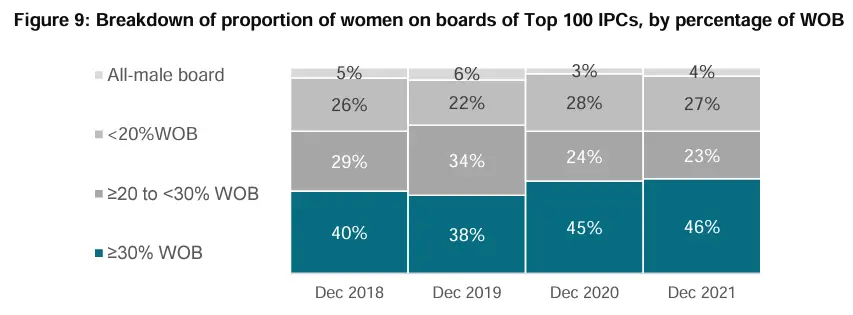
4. Little change in %WOB across IPC-sectors. The top IPC-sectors with the highest average %WOB are Community, Social and Welfare, Arts and Heritage, and Education.


Every moment is a teachable moment – learning from diversity